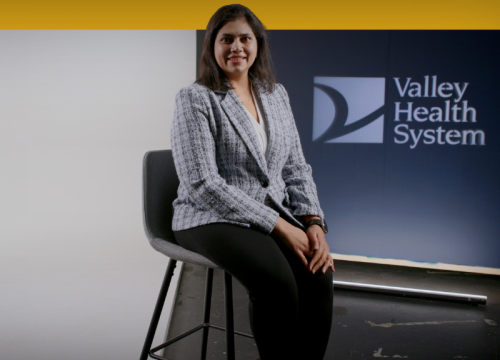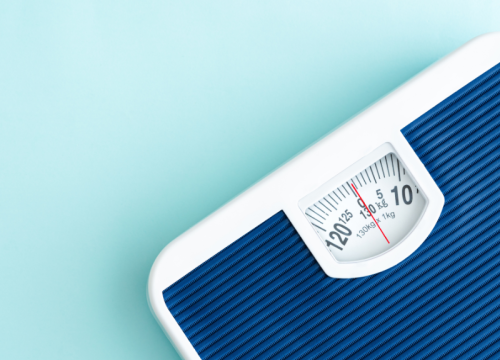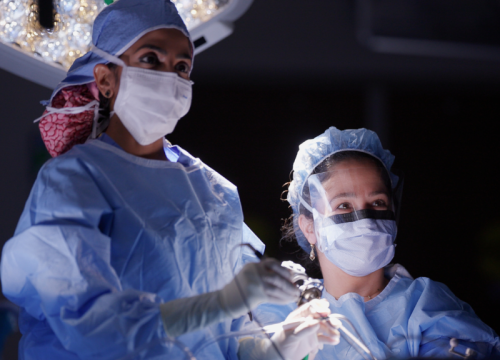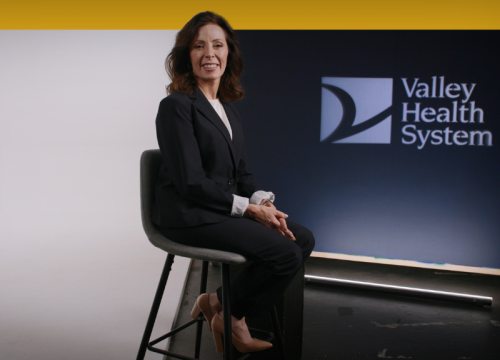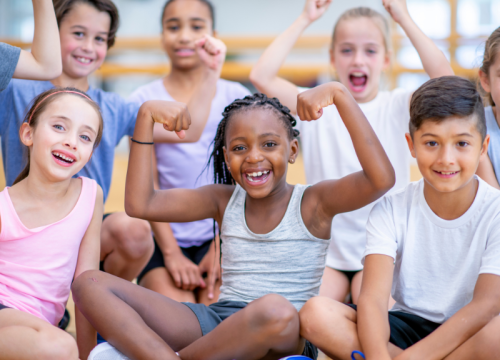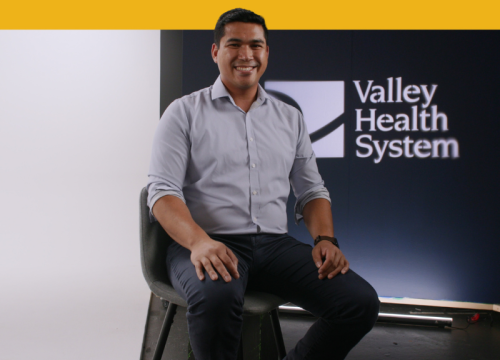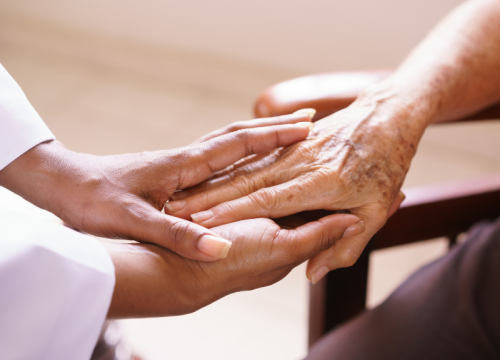Whether you have lung cancer or you’re at risk for the disease, Valley’s Lung Cancer Center team is ready to help.
With leading-edge cancer treatment and compassionate care, we diagnose and treat the two main types of lung cancer: non-small cell lung cancer (NSCLC) and small cell lung cancer.
Lung Cancer Symptoms
Common lung cancer symptoms include:
- Shortness of breath, wheezing or hoarseness
- Chest pain
- Persistent cough or coughing up blood
- Fatigue
- Neck or facial swelling
- Unexplained weight loss or loss of appetite
These symptoms are not unique to lung cancer. See your primary care physician for further evaluation if you’re experiencing any of these symptoms.
Lung Cancer Diagnosis
Lung cancer typically requires examination of a tissue sample (biopsy) for a definitive diagnosis. Valley offers the latest tools to diagnose lung cancer, including endobronchial ultrasound (EBUS), navigational bronchoscopy and minimally invasive biopsy.
Lung Cancer Treatment at Valley
When you have lung cancer, you need the best team of cancer experts around you, access to the latest technology and treatments available, and people who care about you as a whole person. That is Valley’s Lung Cancer Center.
Your lung cancer treatment depends on various factors, including the type of lung cancer and the stage of the disease. Your physician will recommend the best treatment for you and talk you through it.
At Valley, we use a team approach to lung cancer treatment, including the following therapies:
Targeted Therapy: Personalized Medicine
Targeted therapy is a type of cancer treatment that uses drugs to target specific genes, proteins and tissues that contribute to cancer growth. Because not all tumors have the same targets, targeted therapy is a robust and growing field of cancer research, with new drugs frequently becoming available.
Valley stays up to date with new therapies and cutting-edge treatments, including (but not limited to):
- EGFR inhibitors
- KRAS
- ROS1
- ALK inhibitors
- NTRK 1, 2 and 3
While EGFR inhibitors revolutionized lung cancer treatment and are the most commonly used, our pathologists test for other mutations using next-generation methods. This allows us to personalize treatment and target each patient’s specific type of cancer.
We also use mutational analysis on all available biopsy specimens for patients who don’t undergo surgery to remove their tumor.
Immunotherapy
Valley’s cancer program has extensive experience working with immunotherapy and other biologic therapies. We offer immunotherapy for all FDA-approved uses in lung cancer, including first-line treatment for NSCLC.
Immunotherapy allows the immune system to recognize and destroy cancer cells. Because it has been so successful, it is now a first-line treatment for some cancers, along with surgery, radiation, and chemotherapy.
You and your physician will discuss whether immunotherapy would benefit your lung cancer treatment.
Lung Cancer Surgery
If patients have early-stage NSCLC, we typically recommend surgery to remove the cancer. Removing the cancer offers the best chance for a long-term cure.
Operations for lung cancer removal involve two parts. At Valley, these are both performed simultaneously through the same incisions.
- Part of the lung removal: While lobectomy has been the standard of care for many years, based on the latest research evidence, in some cases, we perform a segmentectomy or a wedge resection, which removes only part of the lobe. In certain situations, these lung-preserving operations provide the same benefits for lung cancer treatment as a lobectomy but also preserve more of a patient’s lung.
- Lymph node dissection: When lymph nodes near the tumor are removed, we remove lymph nodes because lung cancers can quickly spread to the lymph nodes. There are no side effects of lymph node removal for lung cancer, unlike what can occur when lymph nodes are removed from other parts of the body for other diseases.
Depending on a patient’s needs, we also perform the following procedures:
- Wedge resection or segmentectomy: This procedure may be appropriate for patients with other lung diseases, such as severe emphysema, who may not be able to handle the whole lobe being removed.
- Pneumonectomy: Some tumors may be very large, requiring the removal of the entire lung (known as a pneumonectomy).
Minimally Invasive Lung Cancer Surgery
At many other institutions, lobectomy and lymph node dissection are performed through a six to eight-inch incision in the side of the chest (called a thoracotomy). In a thoracotomy, the ribs are spread so that the surgeon can see and operate inside the chest.
At Valley, we offer minimally invasive options for these procedures. That means you have less pain after surgery and get on the road to recovery faster.
Using the da Vinci® Surgical System, robotic surgery gives our surgeons a magnified view of the surgical site and the ability to achieve exact precision that human hands can’t accomplish.
Valley offers minimally invasive surgery options for lung cancer removal, including:
- da Vinci VATS lobectomy: Thoracic surgeons use the robotic da Vinci® Surgical System to remove one of the lobes of the lungs minimally invasively instead of through a large chest incision.
Robotic surgery typically offers many benefits to patients, including:
- Ability to perform complex operations that otherwise would have to be done with thoracotomy
- Less pain after surgery
- Faster recovery
- Less blood loss
- Reduced risk of infection
Radiation Therapy
Radiation therapy may be needed for lung cancers that cannot be removed surgically.
At Valley, we use radiation treatments that more precisely pinpoint the radiation to kill cancer cells vs. healthy cells:
- Stereotactic body radiation therapy (SBRT): Valley offers SBRT using the TomoTherapy system. This form of radiation uses a CT scan before each daily radiation treatment to ensure the exact targeting of the tumor.
- Respiratory gating: This system also tracks a tumor’s motion while the patient breathes (known as respiratory gating). This tracking provides the most accurate delivery of treatment. In some patients with small lung tumors, this has allowed doctors to achieve very high cure rates in as little as four treatments.
Why Choose Valley for Lung Cancer?
- Complex surgeries performed robotically: Valley is the first hospital in our region to use the latest generation surgical robot, the da Vinci® Xi™ Surgical System, to provide minimally invasive cancer treatment for our patients. This allows our robotics-trained surgeons to deliver an uncompromising level of steadiness and precision. Our thoracic surgeons also perform lung-preserving operations that will lead to more of your lung being saved.
- Clinical trials: Valley offers clinical trials for many different stages of lung cancer. Clinical trials allow patients to try new, potentially effective therapies before they are widely available.
- Personalized medicine: Through mutational analysis, we personalize treatments to fit your specific cancer’s mutations. This means you receive targeted therapies more likely to work for you.
- Precision radiation therapy: Through SBRT and respiratory gating, you receive less radiation to healthy cells while maximizing radiation to the cancer cells.
- Dedicated thoracic surgery hospital unit: Following lung cancer surgery, all patients are cared for in our dedicated thoracic surgery unit at The Valley Hospital. This specialized unit has dedicated thoracic surgery nurses and a high nurse-to-patient ratio to ensure our patients receive the best care possible after surgery.
- Less time in the hospital after surgery: The combination of minimally invasive surgery and specialized post-surgical care has resulted in shorter hospital stays for our patients following lung cancer surgery. On average, our patients spend two fewer days in the hospital after robotic lobectomy than the national average.




